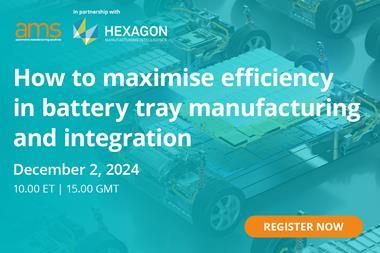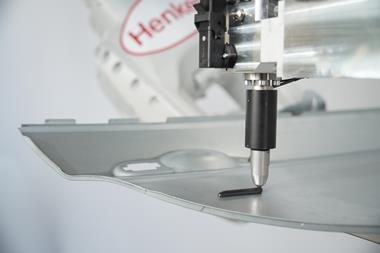As vehicle-makers move towards multi-model assembly lines, a framing innovation enables greater efficiency.
Automotive assembly doesn’t get much more fundamental than framing, the point at which body panels and sub-assembly structures come together to be welded into a single body shell.

Traditionally carried out by low-flexibility framing machines designed for either a single model or a single model and close variants, framing is vital because the process must hold all the pieces of the body shell together with absolute rigidity, in order to maintain the integrity of the shell’s geometry.
That, in short, is its primary mission. As the automotive industry embraces global themes such as lightweighting, the challenge in the framing process is not the actual act of framing but the associated welding processes that take place once the body shell-to-be has been framed.
“Where the art and science of framing are focusing at the moment is on the joining together of new and different materials,” says Neil Dueweke, head of the body structures segment at robotics specialist Fanuc. “The innovation isn’t in the framing itself, but instead it’s how you join the metals together once they are positioned.”
What innovation there is, he adds, is centred around the organisation and internal efficiencies of the framing process, rather than any fundamental re-design of framing itself.
“It’s a bit like different religions – they’re not ‘better’ than each other, just different” is how Dueweke characterises it. “Should the welding robots be on the floor, in order to be more maintainable and reduce downtime, or should they be suspended overhead on a mezzanine floor, in order to reduce clutter and improve cleanliness? You’ll find advocates of both viewpoints.”
ABB’s gateway to a new type of framing
At Changan Ford Automobile, the 50-50 joint venture in China which is headquartered in Chongqing, another perspective on framing is evident; one which encapsulates that primary mission of flexibility and modularity. The site has installed ABB Robotics’ Gate Framer robotic car body framing system, which was launched in June this year. The new system builds on ABB’s nearly 20 years of framing experience – two decades which have given rise to such developments as the Preciflex framing system, launched in 1996, and the FlexFramer, launched in 2000.
Comprising framing robots, a sortation unit and storage units for gates which are not in use, the Gate Framer framing station works by offering steel tooling gates to hold the body structure firmly in place, with a custom-designed gate docking feature delivering a repeatability of +/-0.1 mm in terms of positioning.
Up to four integrated welding robots can be placed just behind each gate for easy access to the body side, along with six shelf-mounted robots on an overhead platform, allowing a total of up to 14 robots to be incorporated into each framing station. The company says that as many as 77 geometry welds can be completed inside the framer, ensuring the geometric integrity of the vehicle.
The advantage over conventional framing machines is immediately obvious: to frame a new model, all that required are different gates. But in an automotive industry currently undergoing a huge push towards flexibility and multi-model assembly lines and plants, it turns out that ABB’s Gate Framer powerfully extends the multi-model production agenda directly into the framing process itself.
 Since the ABB Gate Framer can handle multiple gates, with each set of gates representing a different model, switching models requires no more than switching gates. If this can be carried out automatically, without adversely impacting on cycle times and the production rate of the line, then multimodel manufacture becomes much more practical.
Since the ABB Gate Framer can handle multiple gates, with each set of gates representing a different model, switching models requires no more than switching gates. If this can be carried out automatically, without adversely impacting on cycle times and the production rate of the line, then multimodel manufacture becomes much more practical.
This is exactly what the Gate Framer delivers. While welding is being carried out on the body shell which is clamped in the in-use gates, ABB’s IRC5 robotic controller is rearranging gates in the background, positioning them for a model switch.
The result is that up to six different car body variants can be framed on the same line, by swapping the gates which hold each model’s tooling. With the IRC5 sequencing the framing gates in the background, a consistent gate exchange time of only 18 seconds can be achieved, even for a random sequence of model production. ABB believes this gives production planners unparalleled freedom to adjust mixed model sequencing on any given line, in order to meet current demand.
A further aspect of this modularity is that the model range of the Gate Framer can be expanded as needed. From a base layout of a single car model, investment in the system can gradually increase over time, with new car models being accommodated simply by adding new gates – thus allowing capital outlay to be scaled to meet demand.
“Modularity is important,” says Alan Stapelberg, ABB Robotics’ body-in-white product manager, “but it’s not just about flexibility. Certainly, customers like the idea of being able to frame multiple models on the same line, but they also want to add and remove models while matching the investment cycle.
“They also like the idea of re-usable capital investment, with investments in production capacity spread over multiple models, and multiple model lifecycles.”
"Certainly, customers like the idea of being able to frame multiple models on the same line, but they also want to add and remove models while matching the investment cycle. They also like the idea of re-usable capital investment, with investments in production capacity spread over multiple models, and multiple model lifecycles." - Alan Stapelberg, ABB Robotics
Modularity is also a strength in operational terms. “A very modular piece of equipment means that you’re not interfering with existing equipment when making changes, and that’s important,” adds Stapelberg. “Simplicity of programming is also a growing requirement; put the two together and it provides the ability to add a new model to a line without affecting existing production.”
By replacing custom-made framing machines with a robust product based around a standardised and validated design using proven components and technology, higher assembly line uptime should result, says Stapelberg. Moreover, according to ABB the Gate Framer is designed for a lifetime of over a million cycles, requires very few spare parts and needs little maintenance.
Usefully, too, the IRC5 controller is programmed just like a robot. Stapelberg says no additional training is required, and its coordinated motion handling removes complexity in the programming of interlocks between moving parts, thus preventing clashes.
ABB’s Gate Framer may well have re-written the rules of framing.


































